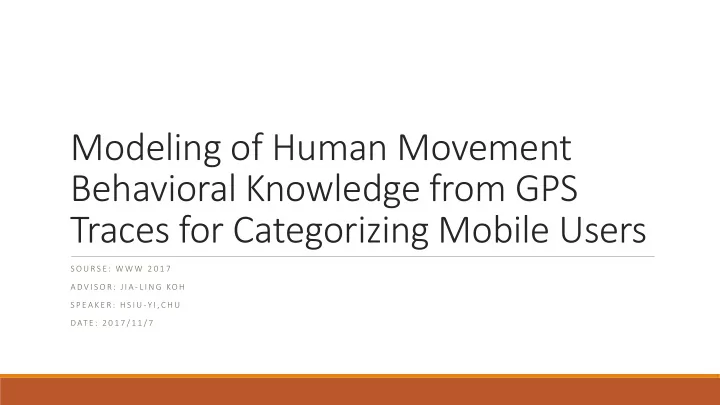

Modeling of Human Movement Behavioral Knowledge from GPS Traces for Categorizing Mobile Users S O U R S E : W W W 2 0 1 7 A D V I S O R : J I A - L I N G KO H S P E A K E R : H S I U - Y I , C H U D AT E : 2 0 1 7 / 1 1 / 7
Outline Introduction Method Experiment Conclusion
Introduction Question Can we map the knowledge of one known region to another unknown(target) region and use this knowledge to categorize the users in the target region?
Introduction Goal Labeled Unlabeled Knowledge GPS log GPS log User category label
Outline Introduction Method Experiment Conclusion
Method
Method User Trajectory Segment <S[], W[], Traj_Win[]> S[]: list of stay points, s = <lat, lon, Geo tagg > W[]: list of waiting points, w = <lat,lon> Traj_Win[]: {S 1 , (x 1 ,x 2 ), (x 2 ,y 2 ), … ,S 2 }
Method User Trajectory Segment
Method Semantic Stay Point Taxonomy(SSP Taxonomy ) SSP Taxonomy :<N, N c , W> N: place type of the Taxonomy N c : associated code of the node place W: aggregated footprints of user
Method Semantic Stay Point Taxonomy(SSP Taxonomy )
Method User-Trace Summary(UTS) N B = <G,Θ>,G=<V,E> v 1i : (N c ,t i ) N c : associated code of the node place t i : temporal value of the node e i : dependences between the vertices
Method User-Trace Summary(UTS) Bayesian Network
Method Θ x5|Pax5 = 0.46
Method Θ x4|Pax4 * Θ x5|Pax5 * Θ x2|Pax2 = 0.6*0.46*0.98=0.27048
Method Temporal Common Sub-sequence, (TempCS)clustering algorithm Similarity measure(Bhattacharyya distance): D B (X 4 , X 5 )=-ln{[X 4 (0)X 5 (0)] 1/2 +[X 4 (1)X 5 (1)] 1/2 }= -ln{[0.4*(0.4*0.32+0.6*0.54)] 1/2 +[0.6*(0.4*0.68+0.6*0.46)] 1/2 }
Method Temporal Common Sub-sequence, (TempCS)clustering algorithm N B1 :X 4 X 3 X 5 X 1 X 2 N B2 :X 4 X 1 X 6 X 5 X 2 Common stay points(L c ):X 4 X 5 X 2 X 1 Common Sub-sequence(L s ):X 4 X 5 X 2
Method Similarity between N B1 and N B2 : Sim Sequence (N B1 ,N B2 )= 3/4[D B (X 4 , X 5 )+ D B (X 5 , X 2 )]
Method User Categorization Classification task: PV u = {p 1 ,p 2 ,…,p i } i: user-category p i : probability of the user u in category i
Method User Categorization Feature f1: visit in types of places f2: Speed of movement or transportation mode f3: User Movement
Method User Categorization Bayesian network When independent Weighting each of feature
Method Transfer Learning
Method Transfer Learning Extract the parent’s code c p of a node c. Node c has n sibling, append n+1 along with the parent’s code c p n+1. Check whether the same place-type in and assign the same code if present. Generate Get the common taxonomy
Outline Introduction Method Experiment Conclusion
Experiment Dataset
Experiment Accuracy of User-Classification
Experiment
Outline Introduction Method Experiment Conclusion
Conclusion Address the user categorization problem from the GPS traces of the users. Propose a framework to model individual’s movement patterns. Transfer knowledge base from one city domain to another unknown city.
Recommend
More recommend